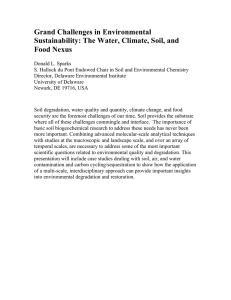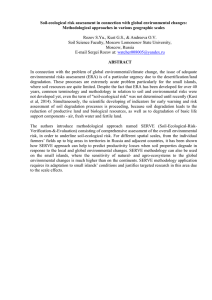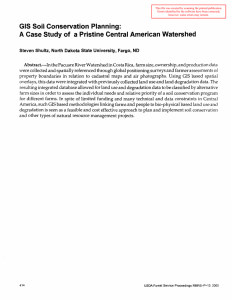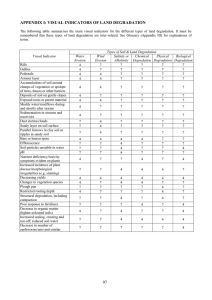Document 14093878
advertisement
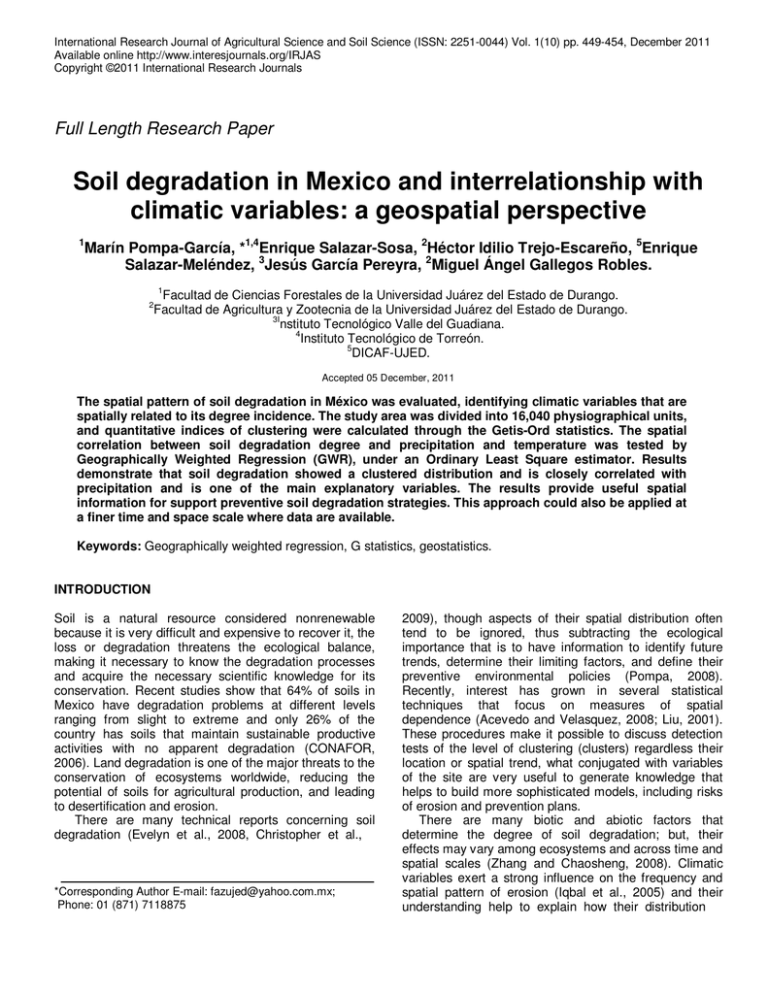
International Research Journal of Agricultural Science and Soil Science (ISSN: 2251-0044) Vol. 1(10) pp. 449-454, December 2011 Available online http://www.interesjournals.org/IRJAS Copyright ©2011 International Research Journals Full Length Research Paper Soil degradation in Mexico and interrelationship with climatic variables: a geospatial perspective 1 Marín Pompa-García, *1,4Enrique Salazar-Sosa, 2Héctor Idilio Trejo-Escareño, 5Enrique Salazar-Meléndez, 3Jesús García Pereyra, 2Miguel Ángel Gallegos Robles. 1 Facultad de Ciencias Forestales de la Universidad Juárez del Estado de Durango. Facultad de Agricultura y Zootecnia de la Universidad Juárez del Estado de Durango. 3I nstituto Tecnológico Valle del Guadiana. 4 Instituto Tecnológico de Torreón. 5 DICAF-UJED. 2 Accepted 05 December, 2011 The spatial pattern of soil degradation in México was evaluated, identifying climatic variables that are spatially related to its degree incidence. The study area was divided into 16,040 physiographical units, and quantitative indices of clustering were calculated through the Getis-Ord statistics. The spatial correlation between soil degradation degree and precipitation and temperature was tested by Geographically Weighted Regression (GWR), under an Ordinary Least Square estimator. Results demonstrate that soil degradation showed a clustered distribution and is closely correlated with precipitation and is one of the main explanatory variables. The results provide useful spatial information for support preventive soil degradation strategies. This approach could also be applied at a finer time and space scale where data are available. Keywords: Geographically weighted regression, G statistics, geostatistics. INTRODUCTION Soil is a natural resource considered nonrenewable because it is very difficult and expensive to recover it, the loss or degradation threatens the ecological balance, making it necessary to know the degradation processes and acquire the necessary scientific knowledge for its conservation. Recent studies show that 64% of soils in Mexico have degradation problems at different levels ranging from slight to extreme and only 26% of the country has soils that maintain sustainable productive activities with no apparent degradation (CONAFOR, 2006). Land degradation is one of the major threats to the conservation of ecosystems worldwide, reducing the potential of soils for agricultural production, and leading to desertification and erosion. There are many technical reports concerning soil degradation (Evelyn et al., 2008, Christopher et al., *Corresponding Author E-mail: fazujed@yahoo.com.mx; Phone: 01 (871) 7118875 2009), though aspects of their spatial distribution often tend to be ignored, thus subtracting the ecological importance that is to have information to identify future trends, determine their limiting factors, and define their preventive environmental policies (Pompa, 2008). Recently, interest has grown in several statistical techniques that focus on measures of spatial dependence (Acevedo and Velasquez, 2008; Liu, 2001). These procedures make it possible to discuss detection tests of the level of clustering (clusters) regardless their location or spatial trend, what conjugated with variables of the site are very useful to generate knowledge that helps to build more sophisticated models, including risks of erosion and prevention plans. There are many biotic and abiotic factors that determine the degree of soil degradation; but, their effects may vary among ecosystems and across time and spatial scales (Zhang and Chaosheng, 2008). Climatic variables exert a strong influence on the frequency and spatial pattern of erosion (Iqbal et al., 2005) and their understanding help to explain how their distribution 450 Int. Res. J. Agric. Sci. Soil Sci. Figure 1. Location of the study area patterns range to determine where it is most likely that this occurs. Thus it appears that in the formulation of strategies and actions for the management of land degradation is essential to have reliable information about the nature of the conditions that favor its occurrence and causal agents. In this context it is of great importance to study the influence of climatic variables, given the need for historical background to base the design and implementation of programs to prevent soil loss. That is why the objective of this study is to find the explanatory variables of spatial pattern that follows the occurrence of degradation in the Mexican Republic, with the hypothesis that this pattern is based on climatic variables. MATERIALS AND METHODS the 16,040 terrestrial systems of Mexico which includes climatic data of mean annual precipitation and temperature and a classification of the degree of soil erosion, in terms of reducing the biological productivity of the land, four levels were considered: (1) Slight: the lands are suitable for local forest, agricultural and livestock systems and show a slight perceivable reduction in productivity. (2) Moderate: lands suitable for forest, agricultural and livestock systems have a marked reduction in productivity. (3) Strong: At farm level, degradation of this land is so severe that its productivity is considered irreversible, unless huge engineering work is applied for its restoration. (4) Extreme: land productivity is unrecoverable and it is not possible to restore it. Description of the study area Spatial analysis he Mexican Republic is located between latitudes of 14º32’ and 32º43’N and longitudes of 86º42’ and 118º27’W. To the north, it borders with the United States of America, to the south with Guatemala and Belize, to the east with the Gulf of Mexico and to the west with the Pacific Ocean (Figure 1). Considering that for each of the physiographic units their Cartesian coordinates are known, through G-statistics test that was developed by Ord and Getis (1992) is possible to detect whether the degrees of degradation are clustered together in units with high value or low values. The G-statistics is defined by the following formula: N The database was obtained from the area of geomatics of the National Forestry Commission (Conafor, 2006) and consisted of a coverage in format “shapefile” with data of N ∑∑ w (d ) x x Data G= ij i =1 j =1 N N i i≠ j ∑∑ x x i i =1 j =1 j j García et al. 451 Figure 2. Spatial intensity estimated of the degree of soil degradation to the Mexican Republic. Where xij is the measurement of the attribute for unit i and j respectively; and wij (d) is a measure of one/zero in a symmetrical spatial matrix to detect the vicinity between i and j and the distance given by d. Once known the kind of grouping of the degree of degradation for each physiographic unit a regression analysis was performed for spatial data using the methodology of Geographically Weighted Regression (GWR). The basic idea of this technique is that the parameters can be calculated given a dependent variable and a set of one or more independent variables, whose values have been measured in places where their location is known. If parameters for a model somewhere u wants to be estimated, observations that are closer to the location of the place u should have greater weight in the estimation of the observations that are further away (Charlton and Fotheringham, 2009). Technically, this regression uses information from all points that are around of a point of analysis, attributing more weight to data close to the point and less to those far away; the equation that uses this technique using the estimator OLS (Ordinary Least Squares) is the following: yi(u)= β0i(u)+ β1i(u)x1i+ β2i(u)x2i+…+ βmi(u)xmi where yi is the dependent variable; β0i to βmi indicate the parameters that describe the relationship around the coordinates (u) of the i–th point in the space (specific of the site) and xmi is the m–th variable in the i–th point of the other predictor variables for yi. The degree of clustering of the degration per cartographic unit was considered as the dependent variable (G value) and the independent variables were temperature and precipitation. Both the G-statistics and regression were computed in the program ArcMap™ version 9.3 of ESRI. RESULTS AND DISCUSSION In order to test whether the observations are spatially dependent, Figure 2 shows the cluster found for degrees of degradation in terms of probabilities. The units of red indicate clusters with high values of attributes or clustering, while the greens represent locations with low values of clustering. Finally, the yellow indicate areas where there is not concentration of high or low values. This occurs when the values of the neighbors are close to average or when the evaluation point is surrounded by a mixture of high and low values. According to the graphical results in Figure 2, it is clear that the spatial association of severely degraded areas, occurs in arid ecosystems which makes assume that these ecosystems show increased susceptibility to degradation, for reasons related to lack of moisture. On the other hand, in general terms it is observed that the territories covered by jungle and forest have the lowest 452 Int. Res. J. Agric. Sci. Soil Sci. Table 1. Statistics for the considered variables. Variable Intercept Temperature Precipitation Coefficient 5.524902 0.163011 -0.008183 Probability 0.000000* 0.000000* 0.000000* Pr Robust 0.000000* 0.000000* 0.000000* VIF [1] -------8.65792 1.00558 Note: * denotes statistical significance at 0.05 Table 2. Statistical results obtained by ordinary least squares. Information Criterion (AIC) Adjusted R2 Joint F Statistics Joint Wald Statistics Koenker (BP) Statistics Jarque-Bera Statistics 586.276 0.948 11407.329 480.789 1118.052 134689.9 Probability (> F) 0.000000* 0.000000* 0.000000* 0.000000* Note: * denotes statistical significance at 0.05 degradation levels, which in turn are correlated with each other, attributed to the presence of woody cover, which is consistent with that found by Cerdá (1998). As for the results of the process to find the causative variables, they reveal that the most significant variable was precipitation, as the temperature was redundant by the multi-colinearity presented (Table 1). The results of global regression model (OLS) show that the variables under analysis are statistically significant, this is shown through the signs of the coefficient of regression (+) plus its magnitude (*) to show that statistical significance; complementarily lower values of probability indicate to the variable that best explains the relationship within the model used, that is, the average annual precipitation is which best represents the spatial pattern of occurrence. The results for the fitted model indicate that the explanatory variables are closely related to the dependent variable as the results show an adjusted R2 of 0.948 and a value of 586.276 for the Akaike information criterion (AIC), where for this case the low values show that the model is the one that can best explain the relationship between variables (Table 2 and Figure 3). F-static and Wald-static statistics show the total relevance of the model, which is statistically significant as well as the Jarque-Bera statistics, which indicates normal distribution of the residuals. As shown in Figure 3, the results are presented in a map of residuals showing the higher and lower predictions of the explanatory variables, distributed through space in each of the map units, showing that there is not spatial autocorrelation in the residuals. Soil is one of the most important components of our ecosystems, so it is important to know the causes of its deterioration. The existence of spatial association in the study variable, as demonstrated by the techniques used in this study, confirms our hypothesis that the spatial pattern showing the soil degradation is strongly influenced by precipitation and provides a new shade of associations of soil erosion, indicating where are the most significant changes, on which researchers and environmental managers must focus their prevention and recovery work. This shows that the incorporation of the spatial dimension in the evaluation of these variables improves our understanding of the spatial patterns of the phenomenon under study. Zhang and Chaosheng (2008), also suggest that the spatial analysis of data at different scales should be a vital part of identifying the foundations of spatial and time distribution. Spatial analysis applied to soil degradation studies has been little used; its application is marked in investigations of spatial trends of outbreaks of contamination of soils (Zhang and Chaosheng, 2008; Chang and Heejun, 2008), spatial autocorrelation of its properties (Dray and Stéphane, 2008; Iqbal et al., 2005; Buscaglia, 2003; and Ducarme and Lebrun, 2004), soil productivity (Ping et al., 2004), and spatial distribution patterns of occurrence and severity of weeds and pests in different soils (Shaukat, et al., 2004; Mueller et al., 2008; Dessaint et al., 1991; Efron et al., 2001; Toepfer et al., 2007). In all cases, the variables studied have shown spatial autocorrelation of some kind, that is, it proves once again Tobler's Law, (1970), the above is consistent with the results found in this study. Other studies in various areas of the Mediterranean show that along climatic gradients, climate underlies as a determinant in the differences of the quality of aggre- García et al. 453 Figure 3. Distribution of residuals of the model Geographically Weighted Regression (GWR) gation, rates of runoff and erosion processes between areas (Boix et al., 1995). In some areas with homogeneous land uses along gradients it has been shown that the influence of climate is the most important determinant of the differences between areas along the climatic-altitudinal gradients, (Cerdà, 1998). For Reynolds and Simith (2002), the variation in annual precipitation is related to soil degradation due to global climatic fluctuations. Thus it appears that for the formulation of strategies and actions for land management is essential to have reliable information about the nature of land degradation, particularly in regard to the conditions that favor the occurrence and the agents of causality. In this context it is of great importance the study of causality given the inevitable need to have sufficient background information to support the design and implementation of prevention programs based on awareness of the agents of erosion risk. erosion, which should be considered as a fundamental part in the preparation of programs to prevent soil degradation. The technique utilized showed to be functional as it is statistically explanatory of the spatial relationship of the occurrence of soil degradation with respect to its location; it can also be replicated to smaller and homogeneous landscape units and in other locations where data are available. CONCLUSIONS REFERENCES The behavior of the degree of soil degradation in Mexico is a selective process in terms of neighboring degraded areas. The influence of mean annual precipitation is largely the determining factor in the degree of the onset of soil Acevedo I y E, Velásquez C (2008). Algunos conceptos de la econometría espacial y el análisis exploratorio de datos espaciales. Ecos de Economía No. 27. Medellín, pp. 9- 34. Buscaglia H y J Varco (2003). Comparación de los diseños de muestreo en la detección de variabilidad espacial de suelos del Delta de Mississippi. Soil Science Society of América Diario, 67 (4), p. 1180. ACKNOWLEDGMENTS It is recognized in a special way the management of geomatics of the National Forestry Commission in Mexico, by the provision of useful information for the present study. We also thank Dr. Carlos Alberto Ortiz Solorio, for their valuable contributions during the course of this work. 454 Int. Res. J. Agric. Sci. Soil Sci. Boix C, Calvo A, Cerdà A, Imeson AC, Soriano MD, Tienessen IR (1995). Vulnerability of Mediterranean ecosystems to climatic change, study of soil degradation under different climatological conditions in an altitudinal transect in the south east of Spain. En Zwerver, S., van Rompaey RSAR, Kok MTJ, Berk MM (Eds.): Climate Change Research. Evaluation and Policy Implications, 763766. Charlton M, AS Fotheringham (2009). Geographically weighted regression, white paper. National Centre for Geocomputation National University of Ireland Maynooth Maynooth, Co Kildare, Ireland. 17 p. Cerdá A (1998). El clima y el hombre como factores de la estabilidad estructural del suelo. Un estudio a lo largo de gradientes climáticoaltitudinales". Cuaternario y geomorfología, 12(3-4):3-14. Chang H (2008). Análisis espacial de la calidad del agua en las tendencias de la cuenca del río Han, en Corea del Sur. Water Research, KOREA (South), 42:13. Christopher D, MJ Gormally, V Knutson, J Vala, J Moran, O Doherty y Mc, Donnell R (2009). Factores que afectan Sciomyzidae (Diptera) en un transecto en Skealoghan Turlough. Ecología Springer, Ireland, 43(1): 117-133. Dessaint F, Chadoeuf R, Rarralis O (1991). Spatial Pattern Analysis of Weed Seeds in the cultivated soil seed bank. J. Appl. Ecol., 28(2): 721-730. Dray S (2008). Spatial ordination of vegetation data using a generalization of Wartenberg’s multivariate spatial correlation, J. Veget. Sci., 19(1): 45-56. Ducarme X, Lebrun (2004). Spatial microdistribution of mites and organic matter in soils and caves. Biol. Fertil. Soils, 39(6): 457-466. Efron D, D Nestel y I Glazer (2001). Análisis espacial de los nematodos entomopatógenos y los ejércitos de insectos en un bosque de cítricos en una región semiárida en Israel. Environmental entomología, Israel, 30 (2):254-261. Evelyn R, K Jüri y M Arno (2008). Correlación espacial de la cobertura del suelo como un indicador de la heterogeneidad del paisaje. Indicadores ecológicos, Estonia, 8 (6):783-794. Iqbal J, Thomasson JA (2005). Spatial variability analysis of soil physical properties of alluvial soils. Soil Sci. Soc. Am. J., 69(4): 13381350. Liu C (2001). A comparison of five distance-based methods for spatial pattern analysis. J. Veg. Sci. 12: 411-416. Mueller O, W George., Young C, William, Whittaker y W Gerald (2008). Análisis SIG de la agrupación espacial y temporal del cambio de malezas en cultivos de semillas de césped. La ciencia de malezas, 56 (5):647-669. Ord JK, A Getis (1992). The analysis of spatial association by use of distance statistics. Geographical Analysis. 24(3): 189–206. Pompa GM (2008). Distribución espacial de la pérdida de vegetación en ecosistemas áridos de México. Métodos en ecología y sistemática 3(3):13-22. Ping J, B Zartman (2004). Exploración de la dependencia espacial de la producción de algodón a nivel mundial y local utilizando las estadísticas de auto correlación. Campo de Investigación de Cultivos, Texas U.S., 89 (2 / 3), pp. 219-236. Reynolds J, S Smith D (2002). Do humans cause deserts? In: Global Desertification: Do Humans Cause Deserts? (eds, Reynolds JF and Stafford Smith DM) Dahlem Workshop Report 88, Dahlem University Press, Berlin, pp. 1-21. Shaukat S y I. Siddiqui Ali (2004). Modelo de análisis espacial de las semillas de un banco de semillas del suelo de cultivo y su relación con la vegetación sobre el suelo en una región árida. Diario de los ambientes áridos, 57 (3), p 311. Tobler W (1970). A computer movie simulation urban growth in the Detroit region. Economic geography 46(2):234-240. Toepfer SE, E Michael, K Ren y U. Ulrich (2007). La agrupación espacial de Diabrotica virgifera, Agriotes ustulatus y en pequeña escala en campos de maíz. Entomología Experimentalis et Applicata, U.S.A., 124, (1): 61-75. Zhang Ch (2008). Use of local Moran's I and GIS to identify pollution hotspots of Pb in urban soils of Galway, Ireland. Science of the Total Environment, Ireland, 398 (1-3): 212-221. WEB PAGES LOADED Conafor (2006). Sistema e-mapas. Gerencia de Inventario Forestal y Geomática de la CONAFOR. http://www.cnf.gob.mx:81/emapas/SystemPolitics.aspx; consultado Mayo 22, 2007.


